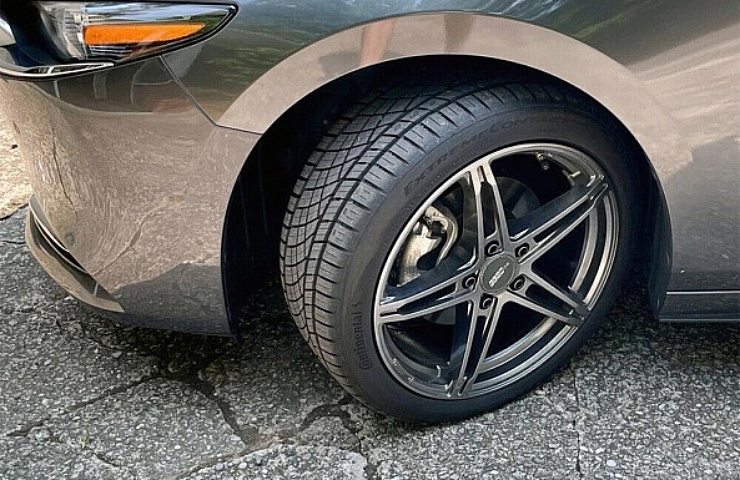Choosing the optimal set of tires for your car or truck requires a bit of research. And that means understanding the basics of tire terminology. So, we put together this glossary to help you get started.
Understanding how to read the sidewall code is also helpful.
All-Season Tires
All-season tires are appropriate year-round in regions without significant winter snowfall. This type of tire delivers good performance and traction—regardless of dry, wet, or light snow conditions.
Aspect Ratio
A tire’s aspect ratio correlates to the tire’s sidewall height—measured from wheel rim to top of the tread. In other words, it’s the height of the sidewall as a percentage of tire width. Lower aspect ratio tires enhance handling, while higher ratios deliver a smoother ride.
Asymmetrical Tread Design
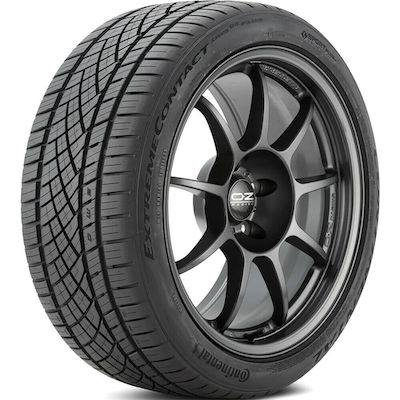
The Continental ExtremeContact DWS 06 PLUS uses an asymmetrical tread pattern.
Asymmetrical tires, like the Continental ExtremeContact DWS 06 PLUS, have tread characteristics that vary from side to side for performance in different road conditions. For example, the inside shoulder typically has more grooves to funnel water, while the outer shoulder has meatier rubber to enhance cornering.
Contact Patch
A tire’s contact patch is literally where the rubber meets the road. Inflation impacts the size of the patch, with over-inflation making it smaller. Larger contact patches enhance handling due to increased grip.
DOT Markings
Department of Transportation’s (DOT) markings are on every street-legal tire sold in the United States. The Tire Identification Numbers (TIN) start with the letters “DOT,” followed by 8 to 13 alphanumeric characters. These characters identify the tire by manufacturing location, size, and type, along with the manufacturing date code (week/year).
Groove
Tread grooves are the wide channels encircling a tire between the tread ribs. The grooves funnel water out of the contact patch to avoid hydroplaning.
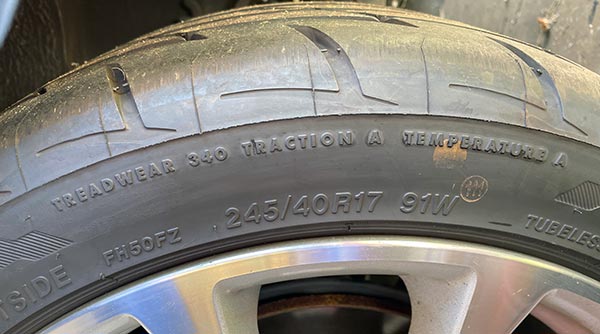
The Firestone Indy 500 Firehawk is an affordable asymmetrical W-rated performance tire.
High-Performance Tires
High-performance tires have higher speed ratings than typical tires. As a result, they provide a higher grip and cornering capability. Classifications include maximum performance and ultra-high performance. While top performance tires deliver more grip when dry, they are louder and stiffer.
Highway Tires
Highway tires are sometimes referred to as “summer tires.” You should not use them in snowy conditions.
Light Truck Tire
Light truck tires (LT) are appropriate for half-ton and smaller pickup trucks, vans, sport utility vehicles, and brawnier crossovers. LT tires use deeper tread and stiffer sidewalls than passenger tires.
Load-Carrying Capacity
A tire’s load index rating is the official certification for weight capacity at maximum tire pressure. For example, a 185/60R15 tire with a load index of 84 is designed to carry 1,102 pounds per tire. Meanwhile, a similar-sized tire with an 88 load index earns a 1,235-pound rating.
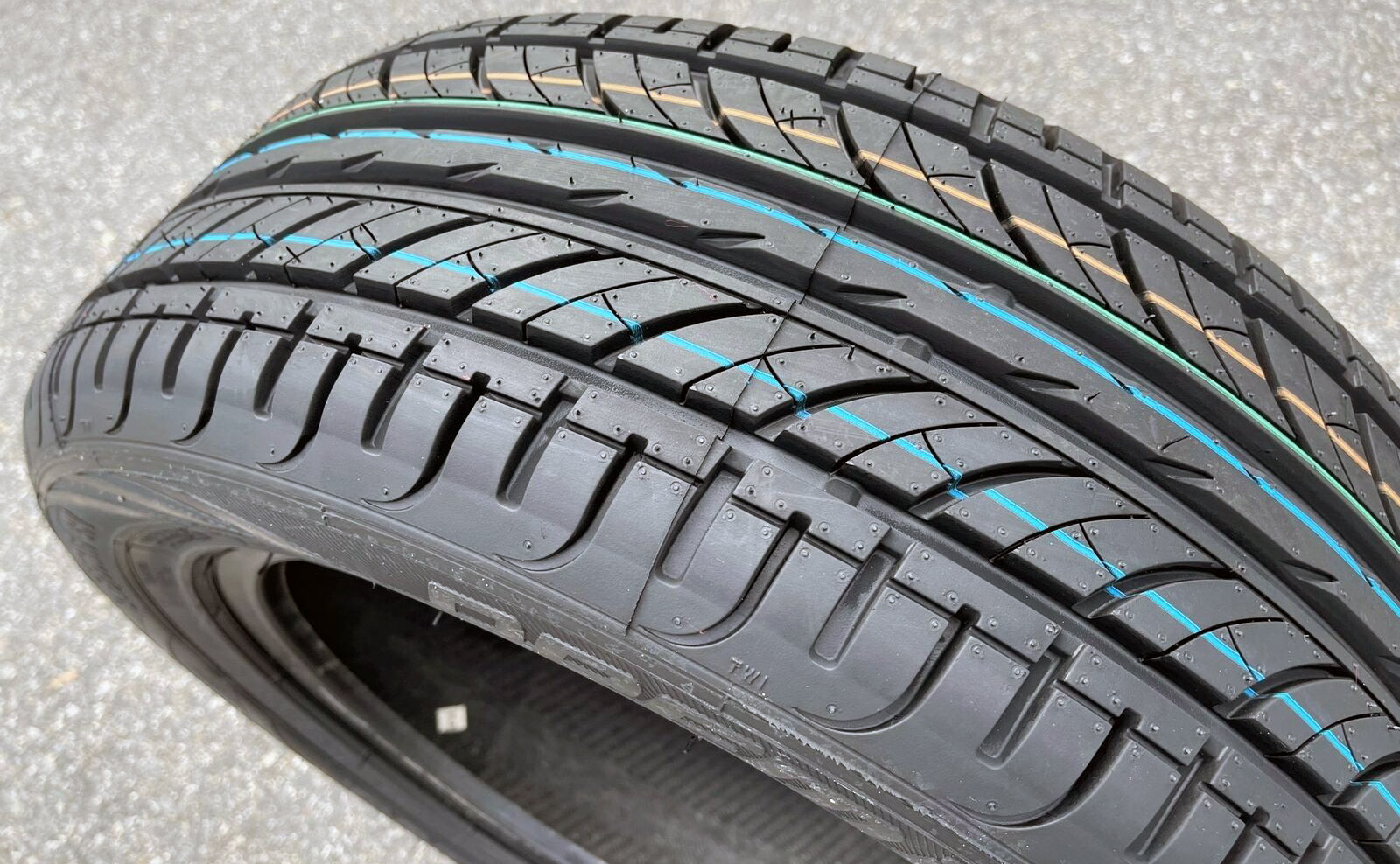
The Premiorri Solazo 185/60R15 84H performance tire has a symmetrical tread pattern.
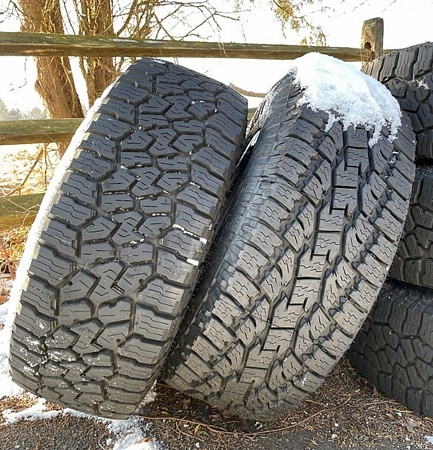
Can you guess which M+S Jeep tire is three-peak rated?
M+S, M/S, and M&S
If you need to go in mud and light snow, look for these letters on the tire’s sidewall. M+S tires are all-season tires, not true winter tires. For serious snow, a set of three-peak tires get the nod. The Falken Wildpeak A/T AT3W (on the left) passes the test, but the Toyo A/T Open Country does not.
Maximum Inflation Pressure
Every tire has a maximum inflation pressure marked on the sidewall. Always fill your tires when they are cold. You should never exceed the stated maximum. Over- or under-inflation causes premature tire wear. It’s best to stick with the vehicle’s manufacturer inflation recommendation, as displayed inside the driver’s door.
Mounting
Mounting is the process of installing a tire on a wheel. You should always follow mounting with balancing the tires. Replacing a bicycle tire is a DIY job accomplished with hand tools. But car, truck, van, and SUV tires require a tire-mounting machine.
Original Equipment
Original equipment (OE) tires are the specific brand, model, and size tire—exactly how it was on the vehicle when your car or truck left the factory. While sticking with the OE tires is a safe bet, switching to a higher-quality tire can improve ride quality, handling, and efficiency. Upgrading the tires on a clean older Honda Civic, for example, is money well-spent.
PSI
Tire inflation pressure is expressed in pounds per square inch. Manufacturer PSI ratings vary from model to model and occasionally from front to rear. Typical numbers are in the 30-to-40 PSI range.
Radial Ply Tire
Most modern tires are radial-ply, with fabric-like cord plies radiating from the center of the tire at a 90-degree angle to the direction of travel to add strength. Polyester is the most common tire ply material, followed by nylon and rayon.
Ribs
Tire ribs are the tread, separated by channels. The tread ribs provide grip while the channels evacuate water from the contact patch.
Rolling Resistance
Low rolling resistance (LRR) tires—like the Michelin Defender and Bridgestone Ecopia—provide better fuel efficiency via advanced rubber compounds. LRR tires, which typically have higher tread life ratings, are commonly used on hybrid and electric vehicles. See Treadwear Grade (below).
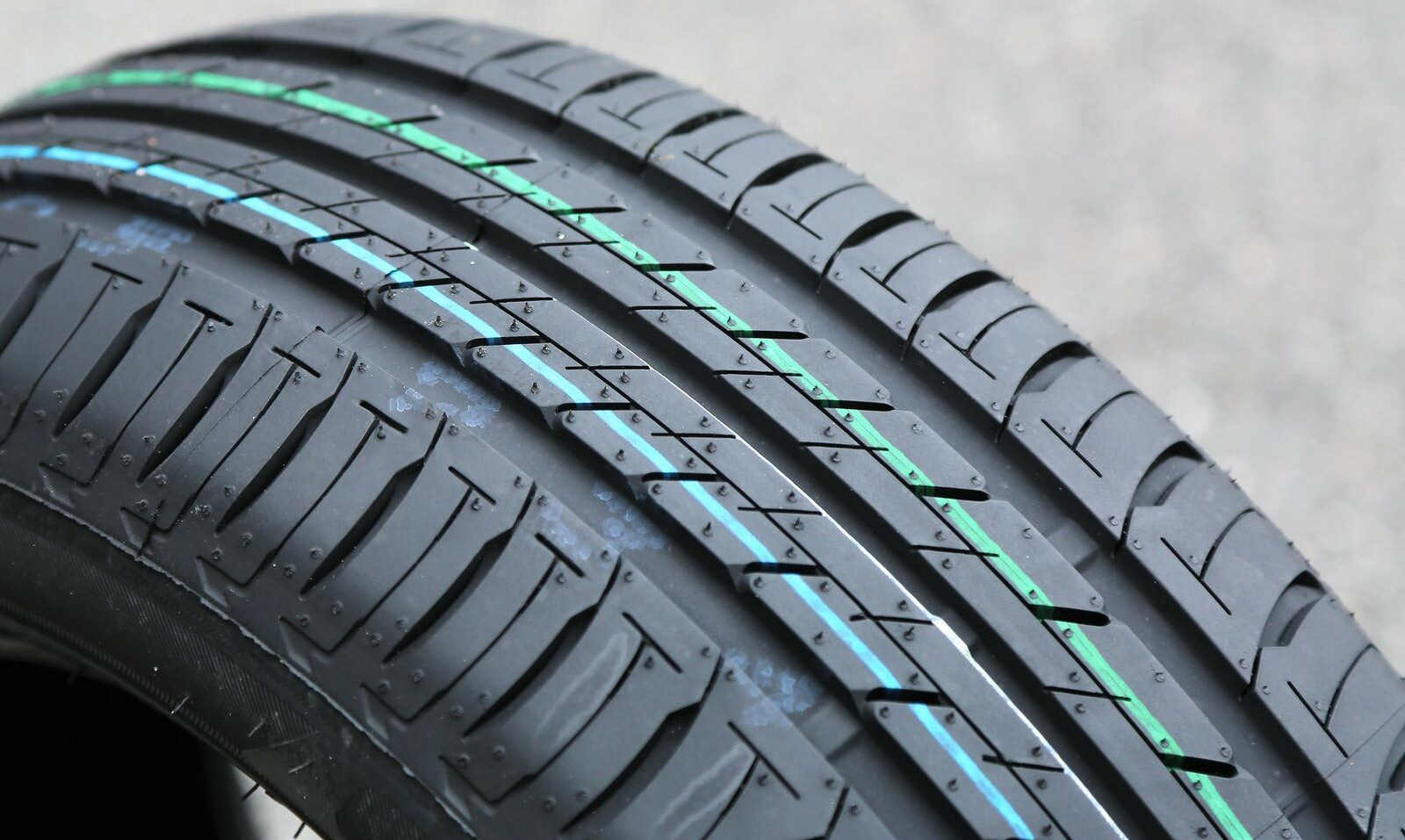
Bridgestone Ecopia
Rotation
Tire rotation is the process of moving tires from front to back and side to side to provide even treadwear. Tire type dictates rotation pattern. For example, staggered tires do not get rotated. Consumer Reports recommends rotating your tires every 5,000 to 8,000 miles. Neglecting tire rotation can lead to shorter tire life.
Run Flat
When punctured, run-flat tires function without air pressure for a limited time at lower speeds. Edmunds states that you can drive “about 100 miles after all the air has gone.” While run-flats reduce the need for a spare tire, they are more expensive than conventional tires. The extra cost of run-flat tires vary from tire to tire, but you can count on spending at least about 50 dollars or more per tire.
Section Height
A tire’s section height is the distance between where the sidewall meets the rim seat and the tread surface. While lower section height can improve handling, shorter sidewalls are stiffer. This results in a rougher ride.
Section Width
A tire’s section width is the distance between sidewalls in millimeters. The larger the number, the wider the tire. Increasing section width can improve handling.
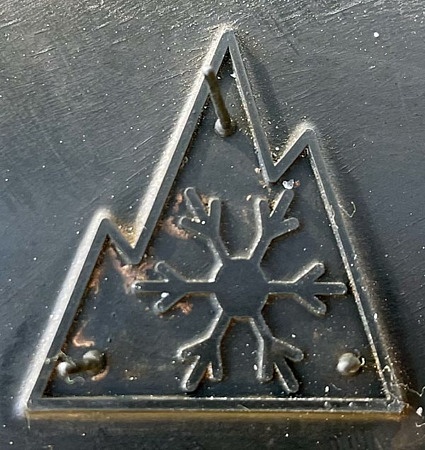
The three-peak symbol.
Severe Snow Service Rated
The “three peak/snowflake” symbol indicates that a tire delivers winter performance above and beyond a standard mud/snow tire. Three-peak tires are a wise investment if you live in an area with significant snowfall.
Shoulder
A tire’s shoulder is where the sidewall meets the tire tread. Your tires may be under-inflated if you notice excessive wear near both shoulders. If the wear is on just one shoulder, your vehicle needs an alignment.
Sidewall
A tire sidewall is the portion of the tire that runs vertically up from the rim to the tire shoulder. More sidewall delivers a comfortable ride while providing enhanced protection from curb rash.
Sipes
Tire sipes are narrow slits that run across the tread to deliver more traction in wet, snowy, and icy conditions.
Speed Rating
A tire’s speed rating indicates the maximum recommended speed in optimum conditions. For example, family sedans and minivans use T-rated (118 mph) tires, while sports cars are often equipped with V-rated (149 mph) tires.
Stagger
Rear-wheel-drive (RWD) drag cars typically use a staggered arrangement. This is sometimes referred to as “bigs and littles.” With RWD cars the larger tires go in the back and narrower tires up front. Some high-performance vehicles wear staggered tires straight from the factory. The 2021 Ford Shelby GT500 Mustang, for example, uses 305/30-20 tires in front and 315/30-20 tires in the rear.
Symmetrical Tread
Most tires use symmetrical tread, with ribs and channels that match from side-to-side. Most passenger vehicle tires are symmetrical, while asymmetrical tires are more common in high-performance applications.
Tire Sizing Information
With a bit of info, deciphering tire size terminology is a snap. For example, a 215/50R17 95V XL tire, has a 215 Section Width and a 50 Aspect Ratio, with Radial construction. It fits on a 17-inch diameter rim and has a Load Index of 95, a V-Speed Rating, and an XL Load Range. See how every character in that string tells a story.
Traction Rating
Traction ratings indicate a tire’s relative braking distance in a controlled straight-line stop in wet conditions. There are four ratings—AA, A, B, and C—running from the shortest to the longest distance. Most quality tires have an A rating. The best high-performance tires earn an AA rating.
Tread Wear Grade
A tire manufacturer tread wear rating indicates longevity. The higher the number, the more miles you can expect. An eco-focused low-rolling-resistance 185/60R15 Yokohama Avid Ascend LX has an 800 tread wear grade, while a high-performance Firestone FR740 carries a 400 rating.
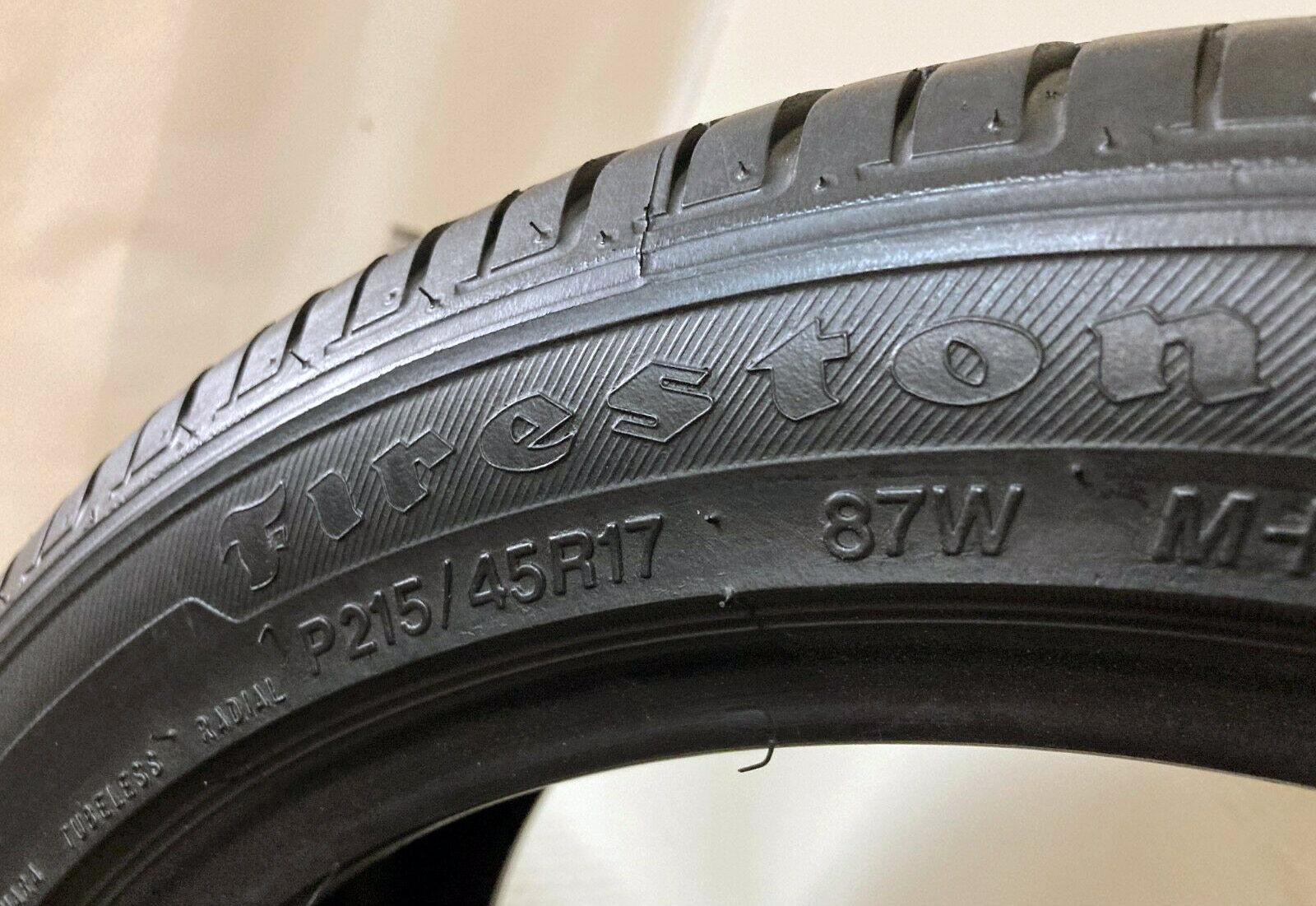
The Firestone Fr740
Tread Wear Indicator
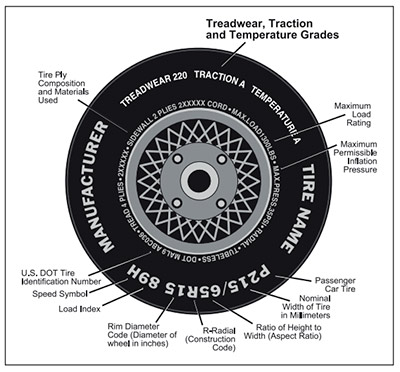
UTQG
The National Highway Traffic Safety Administration (NHTSA) created the Uniform Tire Quality Grading (UTQG) standards in 1978. The UTQG provides comparison points for a tire’s tread wear, temperature resistance, and traction. All DOT-approved tires must display UTQG ratings on the sidewall. The NHTSA’s tire terminology illustration (shown at right) covers all the basics.

